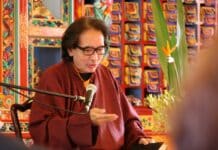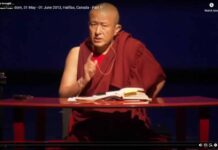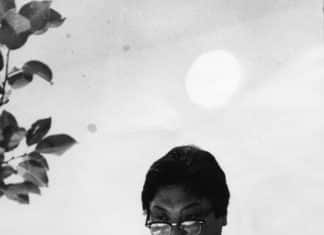Here are a few highlights from Sam’s talk:
On the perspective of contemporary history
So first I’d like to give some perspective. We live in the 21st century and we’re going to talk about a 20th century figure … He lived for the most part in our lifetimes … So the history I’m going to talk about is really contemporary history. But if we look at contemporary history, it is very hard to see. It’s extremely hard to see. To see Trungpa Rinpoche is a very difficult thing because we only see this person who walked this land and taught, gave hundreds of talks, and so on. In terms of a wider perspective of history, Trungpa Rinpoche’s arrival into North America in 1970 is equivalent to Padmasambhava’s arrival into Tibet hundreds of years before that … Trungpa Rinpoche’s arrival in America, and what he did in those seventeen years is one of the most incredible things in Buddhist history. But it will take time for that perspective to be seen.
On extraordinary beings
I was fortunate enough to meet this individual within the first 100 days of his arrival in North America, and I was a very sceptical young man. I was sceptical of him every day of my life while he was alive because I always wanted to see if he really meant what he said … about compassion and putting others before yourself, and all these other nice Buddhist homalies and teachings. I watched him, and I was always looking for him to be ordinary in that way … Now to my utter surprise, in those 17 years, I never saw that man do anything that wasn’t for others. Now that’s an extraordinary thing. It’s hard to run into a being like that, where there is absolutely no deception … What you see is what you get. Trungpa Rinpoche was extraordinary in the same way as the Buddha himself, or as Guru Rinpoche himself, or Yeshe Tsogyal herself. It’s the same mind, and the same intention. Absolutely no difference.
On marking the six realms
… [Trungpa Rinpoche] engaged himself totally into Western life. He looked at [everything], including music, the drug scene, the philosophy of Western thought, theology, dress, fashion, consumerism, sex, drugs, rock and roll–nothing left out–military, war, politics … Basically he explored the six realms in their Western manifestation … He was fearless. He was willing to look at everything, and not only look, but when he looked, he left the mark of enlightenment there, so that if any of his students were looking in those places, wherever they might be, they could find enlightenment there because you knew that Trungpa Rinpoche had been there. There was nothing left out. Now that’s an incredible act of kindness. His curiosity and his compassion created a vehicle for people … Trungpa Rinpoche marked the various realms of samsara with the qualities of wakefulness. Wherever your mind can go, you can wake up there. There is no place your mind can go that hasn’t been marked with wakefulness … It’s up to you. You want to be dull and ignorant? Trungpa Rinpoche taught that dullness and ignorance are not necessarily things you have to continue–even though as he put it, we have been playing the dull ignorant game for thousands of lifetimes, from beginningless time, not paying any attention, being caught by our entanglements of ignorance consistently.
On the language of Dharma
First we have the environment, which is marked, and then we have language, which he also marked. What is so truly amazing is that Trungpa Rinpoche took ordinary English, words that are in the Oxford English Dictionary … [He] took the English language and began marking it with Dharma … Words like ego, neurosis, projection … if you actually look in the dictionary and see what those words mean, and then look at the way Trungpa Rinpoche used them … they have something in common, but they’re not the same words … He created a Buddhist-hybrid English, an actual Dharma English. Now what’s amazing is that we understand that language. He created a language that we can actually understand. Not only that, anyone interested in Buddhism in the West, whether they know it or not, uses his language.
















